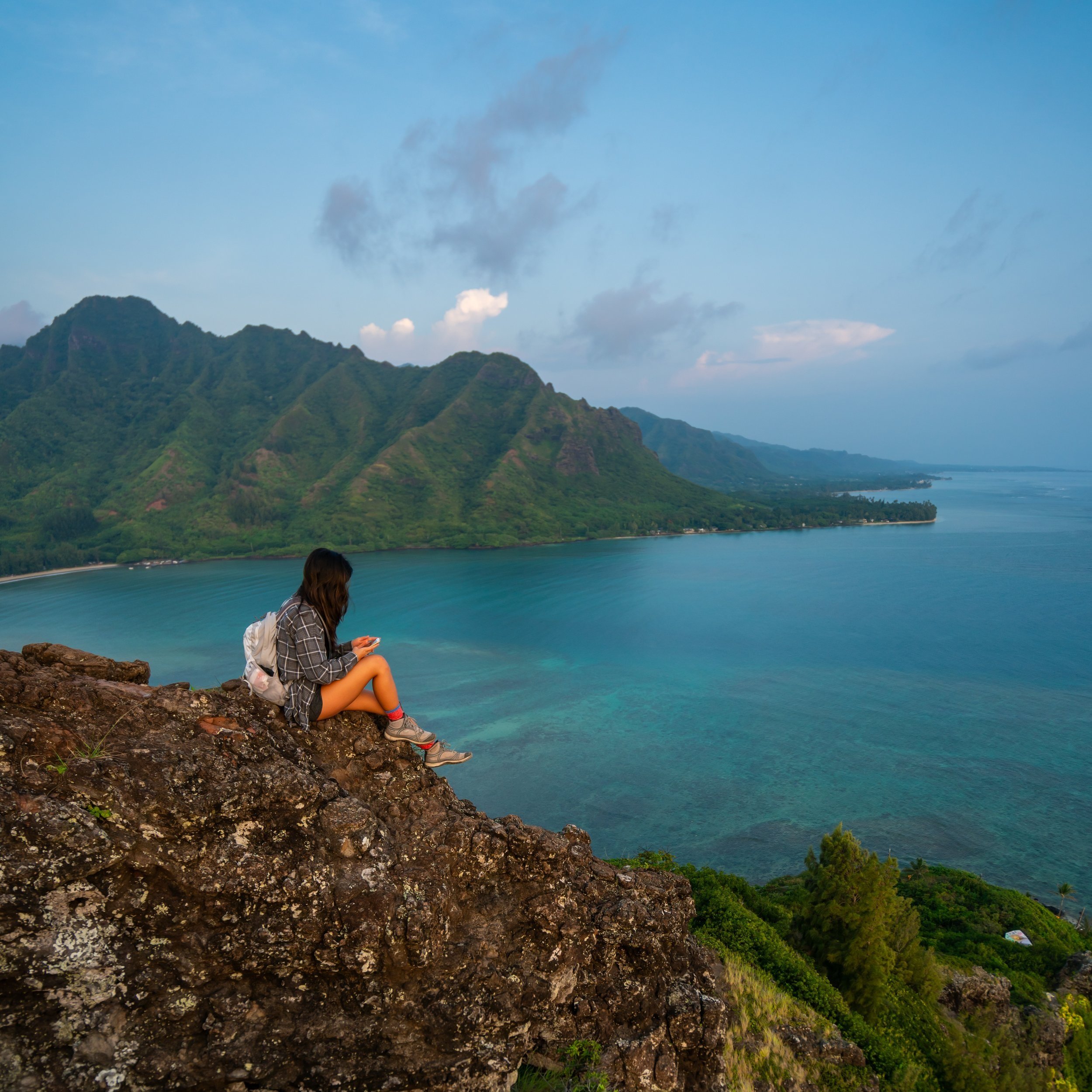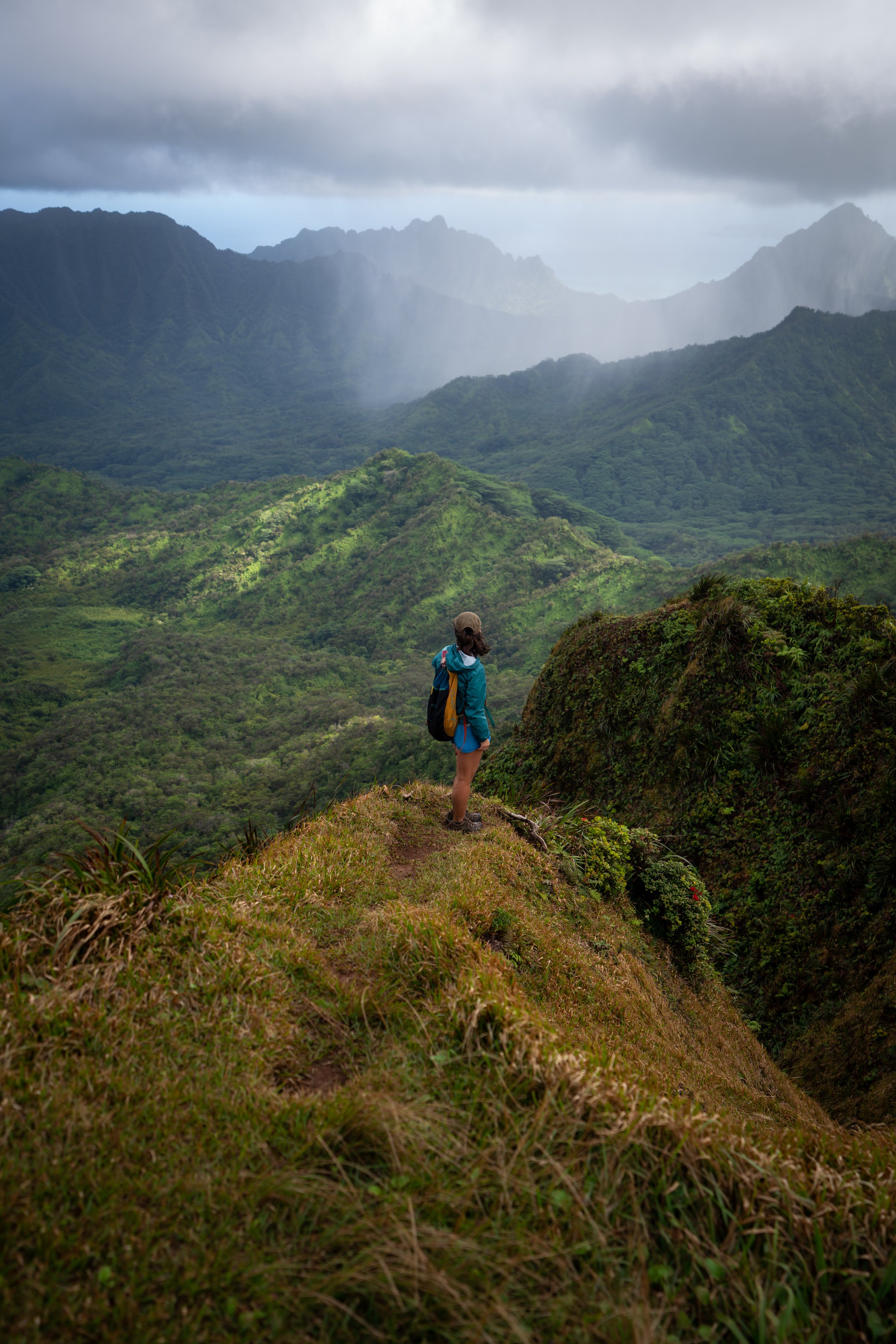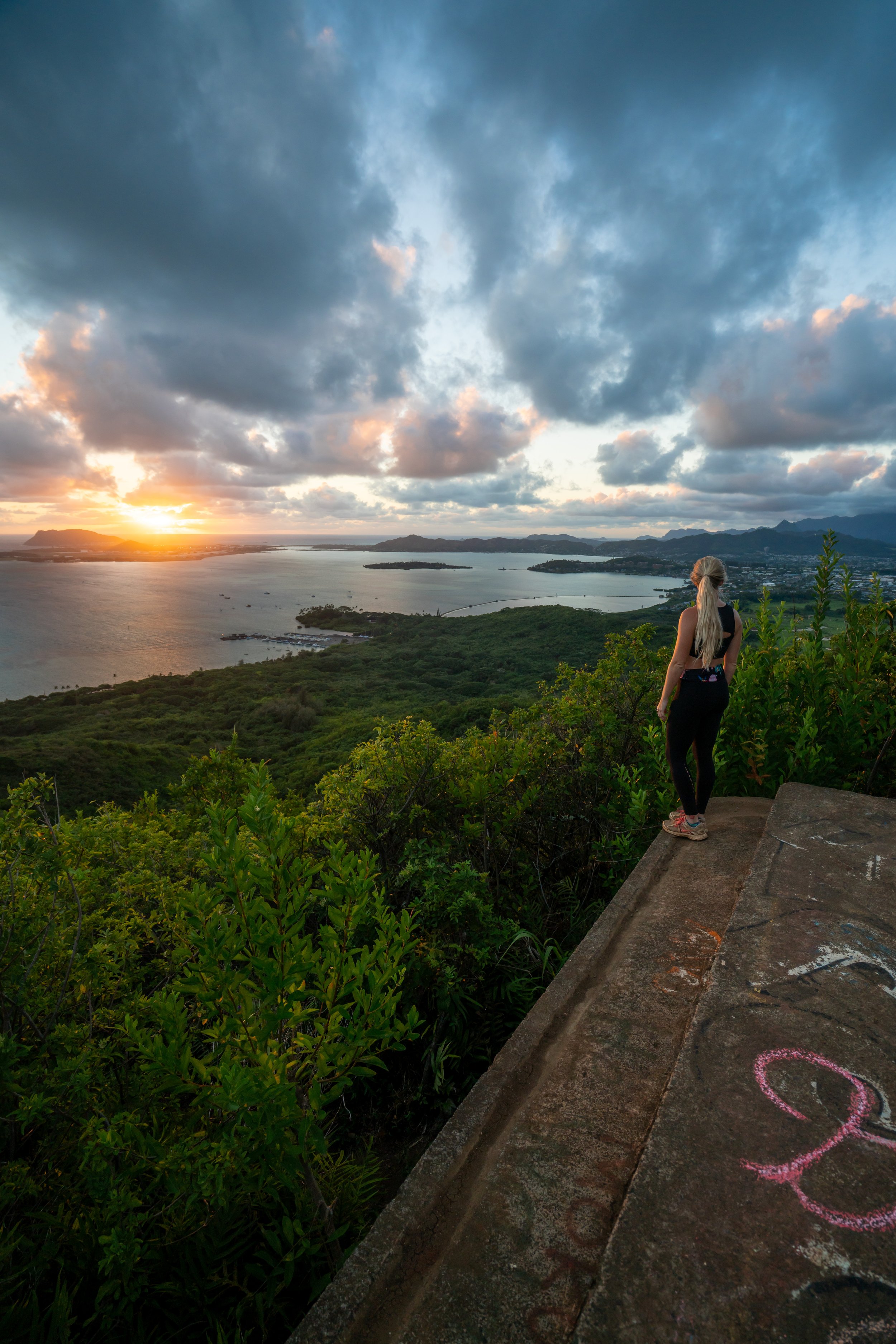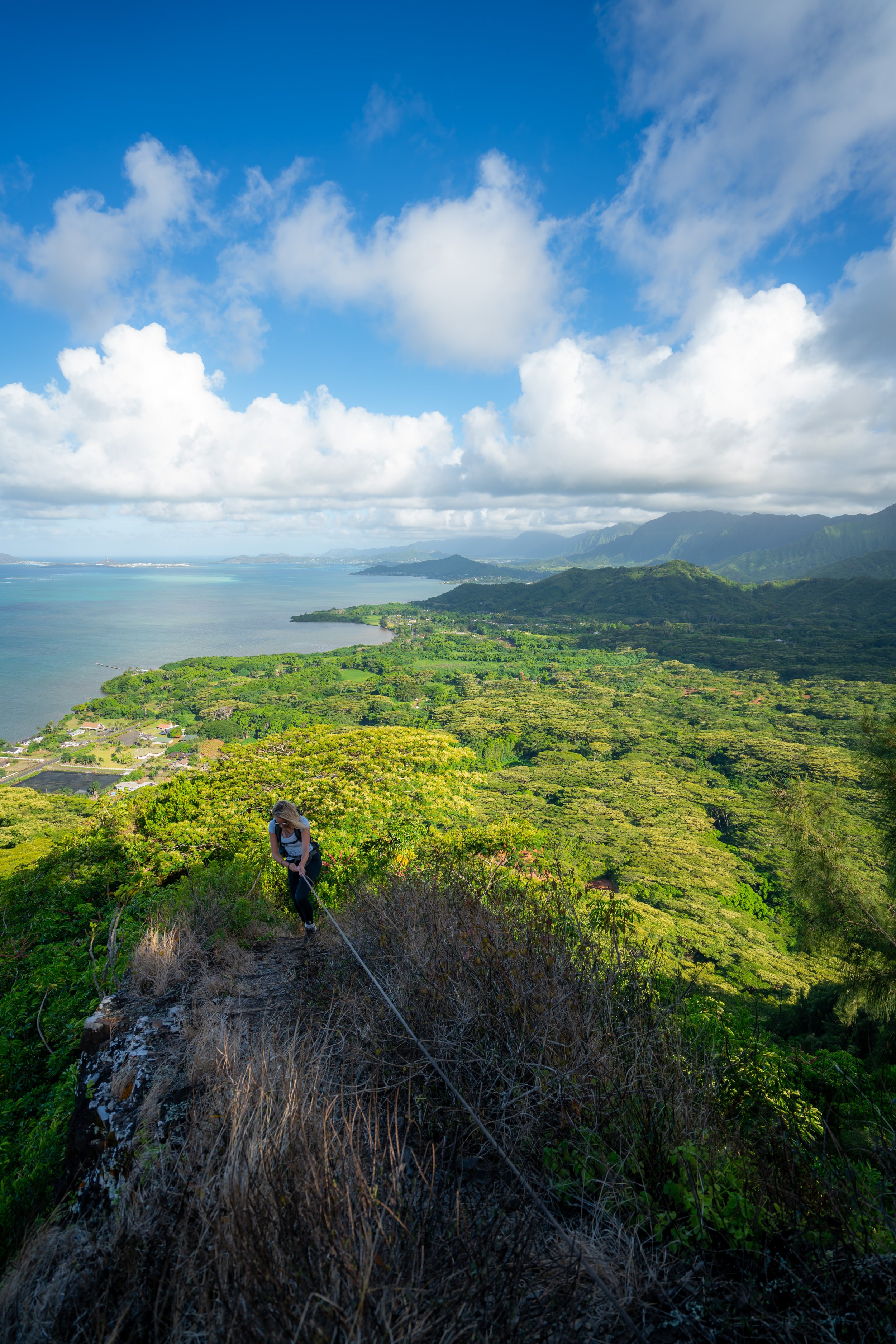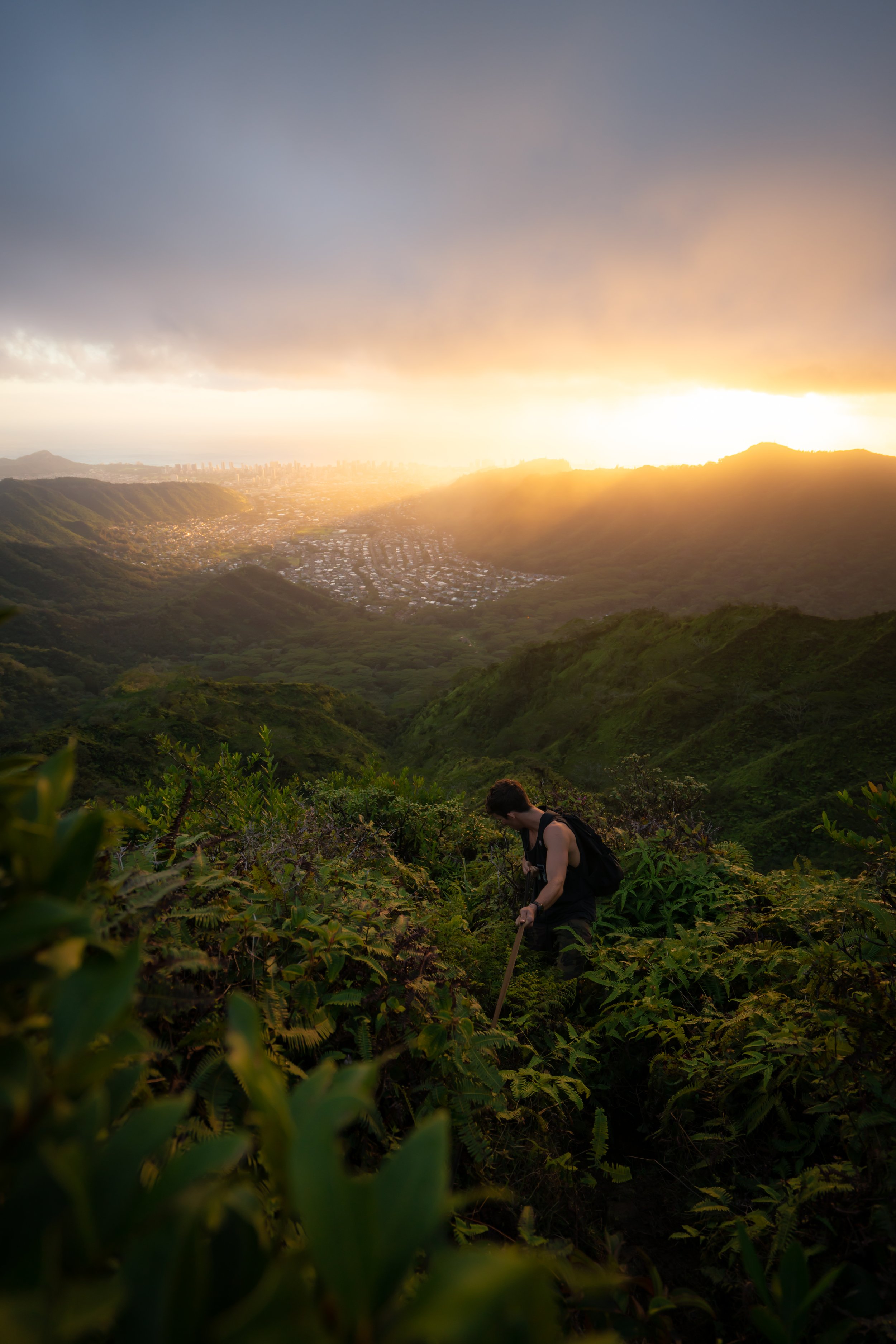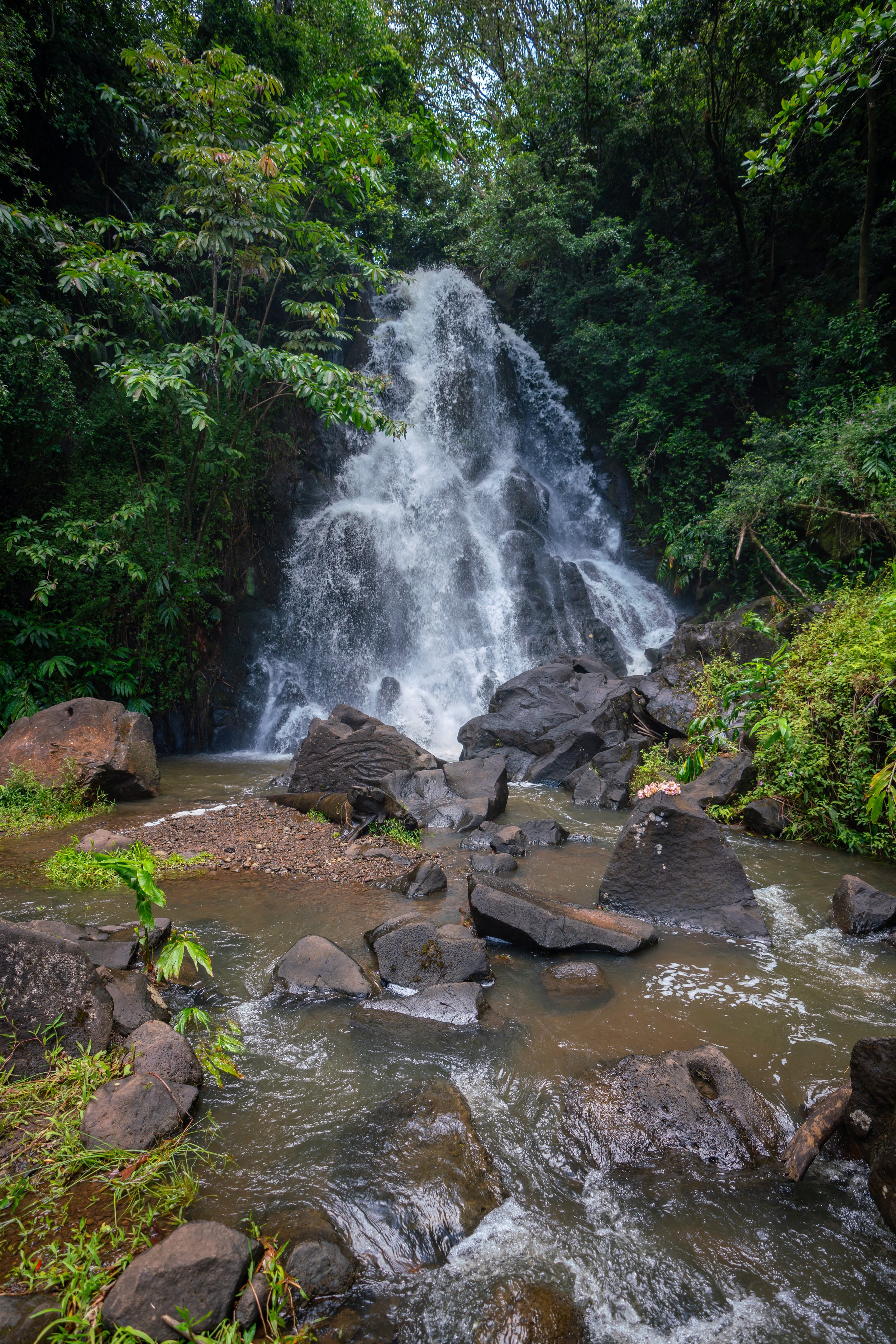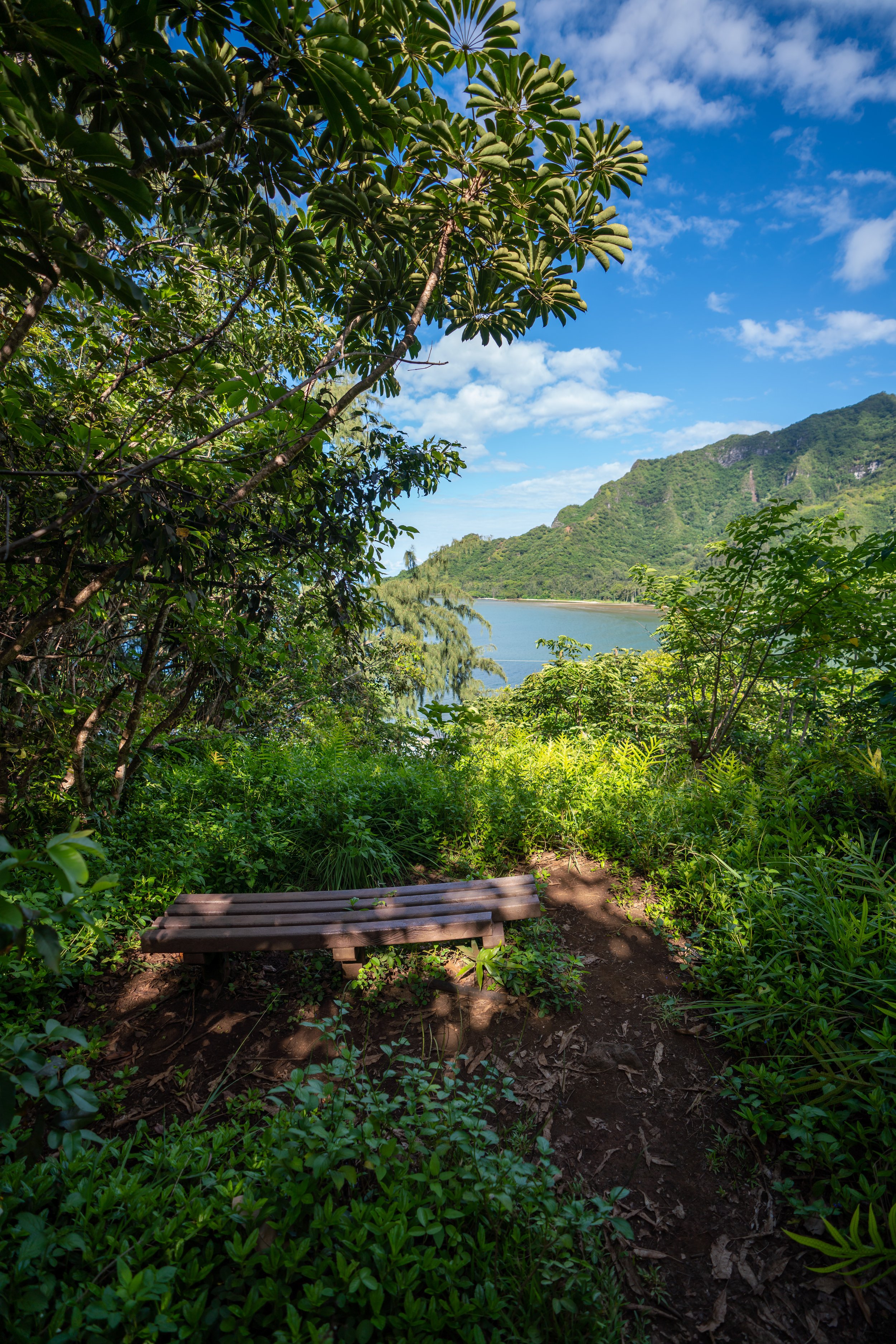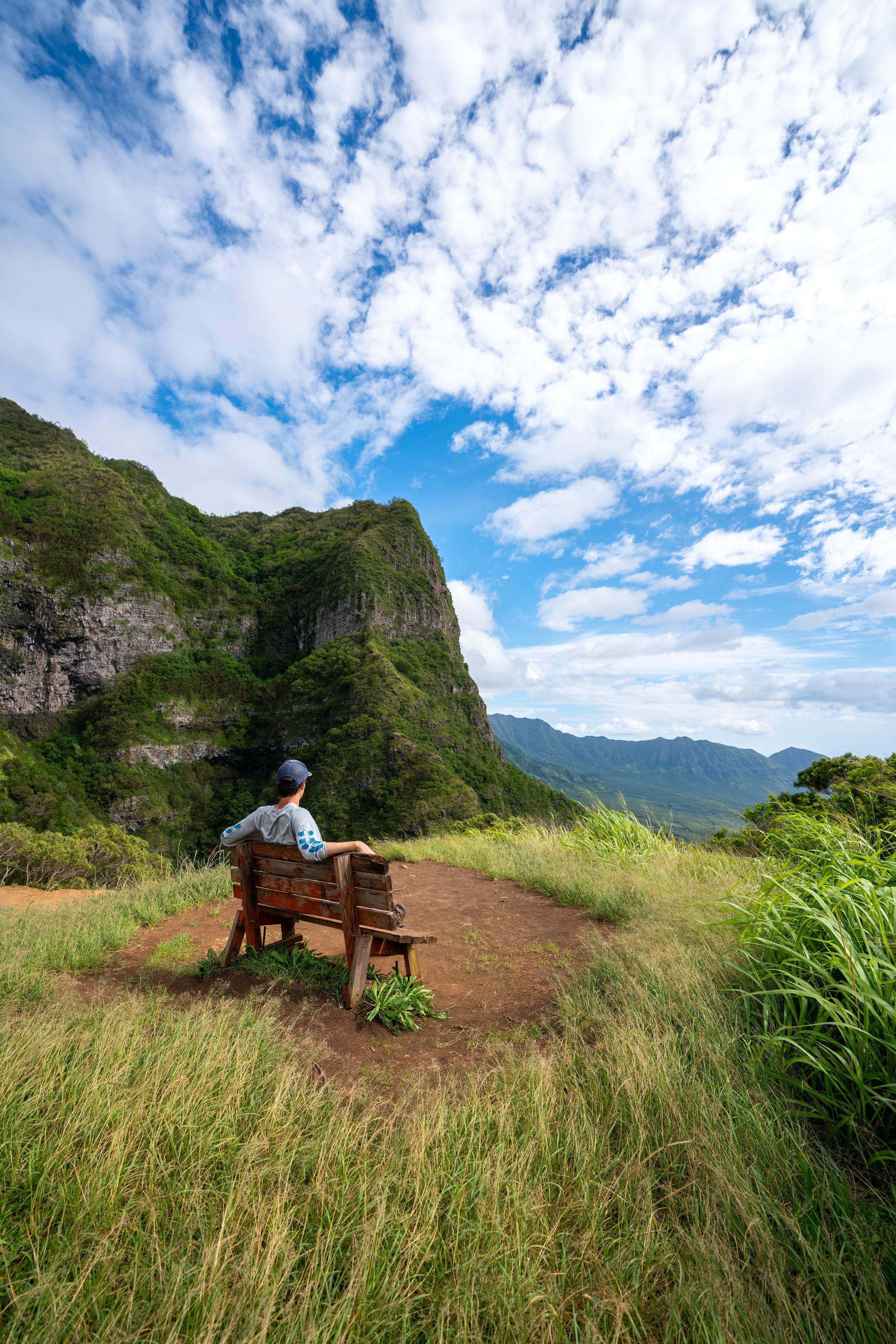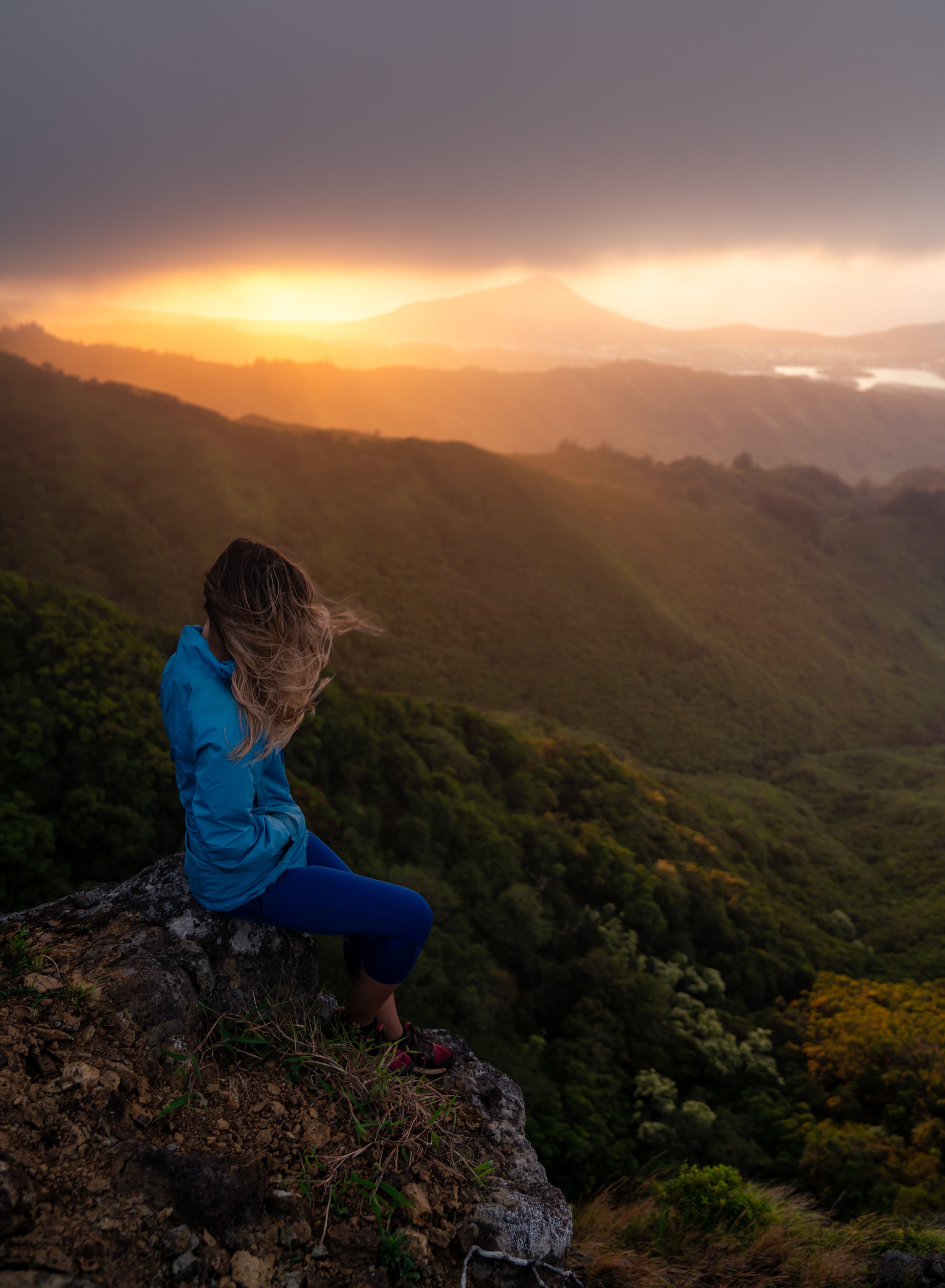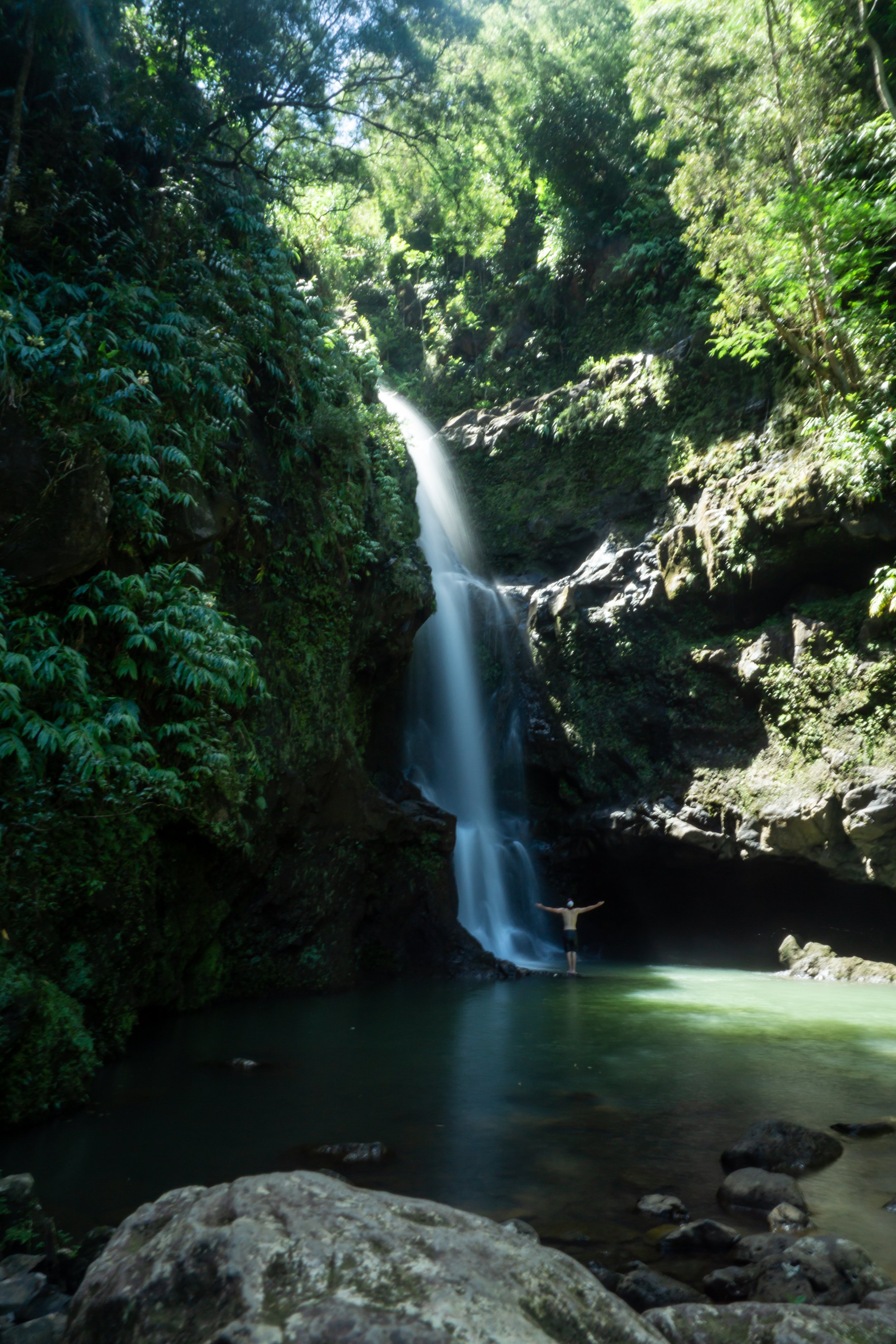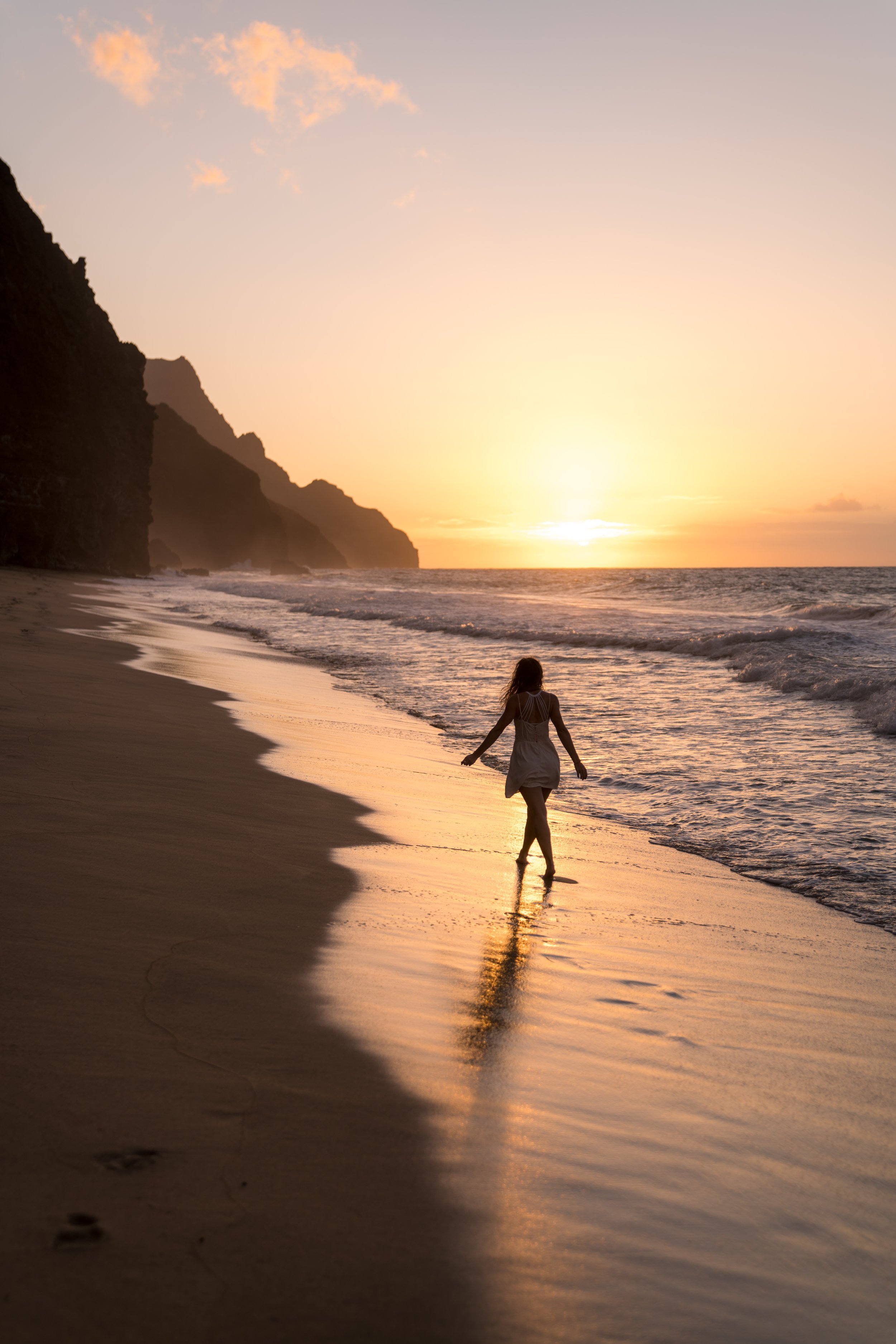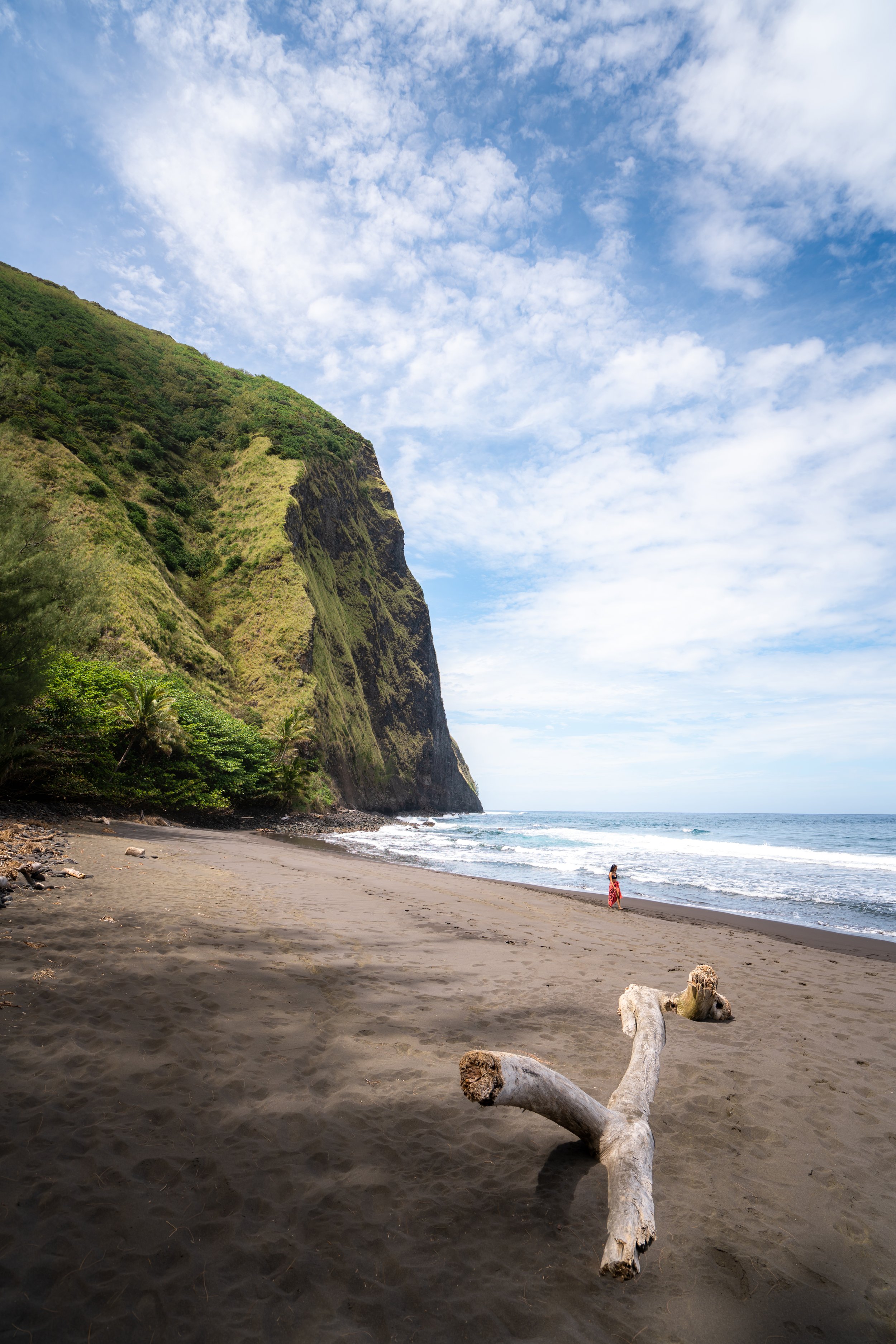Hiking the Puʻu Piei Trail on Oʻahu, Hawaiʻi
Distance: 1.0 - 3.5 miles / 1.6 - 5.6 km
The Puʻu Piei Trail on the east side of Oʻahu is a lot of different adventures in one, depending on who you ask!
For some, Puʻu Piei is simply an out-and-back sunrise hike, while for others hoping to reach the summit via the Piei Makai Ridge, Puʻu Piei is a much more extreme scrambling/ climbing adventure up and down the teeth just prior to the summit.
This doesn’t even mention that there are numerous routes that ascend the east side of Puʻu Piei, which hopefully helps explain why the distance above is so variable.
All this to say, I personally recommend both the North Ridge and Middle Ridge mentioned below, because hiking to the true summit via the Piei Makai ridgeline is not worth the risk. I say this because there are no views from the summit, meaning that the only point in hiking to the summit of Puʻu Piei is to traverse the Piei Makai Ridge 'teeth.'
Puʻu Piei Routes
There are four routes up to the Piei Makai ridgeline, with some being significantly more difficult than others.
In order from north to south, they are the North Ridge, the Middle Ridge, Kila Ridge, and Puʻu Piei Ridge, with Puʻu Piei Ridge being the most direct route to the summit, while avoiding all the teeth along Piei Makai.
That said, both Kila and Puʻu Piei Ridge branch off the Kapaʻeleʻele Trail, while the other two begin off of Kamehameha Highway.
Overall, be aware that any route other than the North Ridge gets much more technical because of the climbing involved.
Puʻu Piei Trailhead Parking
Parking for the Puʻu Piei Trail depends on which route you are taking up to the ridgeline.
For the North and Middle Ridges, parking for Puʻu Piei is located on the north side of Kahana Bay along Kamehameha Highway.
However, for Kila and Puʻu Piei Ridge, parking is best at the Kapaʻeleʻele Trailhead.
Google Maps Directions: North & Middle Ridge Trailhead / Kapaʻeleʻele Trailhead
My Hawaiʻi Hiking Checklist
Osprey 3L Water Bladder - The Osprey 3L water bladder is the most universal hiking and backpacking water bladder on the market, and it’s my go-to because of the slide-off seal that allows it to be quickly filled from the top. Additionally, individual parts are easily replaceable, such as the bite valve.
Blister / Heel Protectors - I swear by these cheap, amazing heel protectors to prevent blisters for nearly every kind of hiking and backpacking that I do!
Black Diamond Headlamp - Personally, I recommend the Black Diamond Storm because it is one of the brightest, lightest, and longest-lasting headlamps on the market—and trust me, the weight-to-battery-life ratio really does matter!
Hiking / Trail Running Shoes - Depending on the type of trail, I prefer to use either the Keen Targhee for longer, more rugged hiking or the HOKA Zinal Trail-Running Shoe for lighter, less intense trails. In either case, both have been amazing to me for many years across countless environments, and both can be found in men’s and women’s sizes. - (Men’s Keen / Women’s Keen) (Men’s HOKA / Women’s HOKA)
Waterproof Rain Shell - You never know when it may rain, and I’ve learned over the years that a rain shell is far better than a rain jacket. By this, I mean that it’s best to have something that the water will roll right off of, which is why I recommend the Patagonia Torrentshell 3L available in both men’s and women’s sizes.
High SPF Sunscreen - Packing high-SPF sunscreen is a must for long days outside!
Hiking the Puʻu Piei Trail
Don’t forget to pack a headlamp for a sunrise hike.
North Ridge
The reason this post is written the way it is stems from both the difficulty and popularity of the routes up Puʻu Piei.
There’s no doubt that the North Ridge up Puʻu Piei is the easiest of all routes, meaning that if you’re simply looking to enjoy the views, choose the North Ridge. The difficulty on Puʻu Piei goes up drastically as you start hiking the subsequent ridges to the south.
The North Ridge begins up an unmarked trail, heading straight uphill off Kamehameha Highway.
If you’re looking at a satellite view, this is the last ridge to the north before the highway turns toward Punaluʻu.
Eventually, the North Ridge crosses over a stream bed that will more than likely be dry.
Look for the trail above the erosion scar on the left.
It can be a little tricky to find.
The second half of the North Ridge is where the hike really starts to get steep.
The last stretch up to the summit of the North Ridge is the steepest and most exposed part of the hike.
However, I think these photos may make this part look more difficult than it is.
North Ridge Summit
The summit of the North Ridge on Puʻu Piei is as far as most hikers go, and for obvious reasons, it’s one of my favorite sunrise spots on Oʻahu.
Compared to the neighboring Crouching Lion, Puʻu Piei sees far fewer hikers, but that being said, the difficulty on Puʻu Piei should not be compared to Crouching Lion or any part of the Puʻu Manamana to Kahekili Ridge Trail.
Simply put, Puʻu Piei is harder.
Piei Makai Ridge
Past the North Ridge Summit, the trail follows the much more overgrown Piei Makai Ridge.
Warning
If you had any difficulty reaching the North Summit, turn around here. As I’ve previously said, the Middle Ridge and every subsequent ridge to the south only get more challenging, exposed, and overall, dangerous.
Additionally, the views don’t get better but worse, as the overgrowth gets worse.
In this post, I show the route along Piei Makai from the North Summit to the Middle Ridge and down, while also showing the start of the infamous Puʻu Piei teeth at the end.
Don’t expect much of a trail between the ridges, but as long as you stay on the ridgeline, it should be as straight forward as it can be.
Middle Ridge
The Middle Ridge on Puʻu Piei is not distinguishable by any landmarks.
The summit of the Middle Ridge is more or less an overgrown hill that you may only know you missed when you get a view looking back at it.
To see the infamous Puʻu Piei teeth, read to the end.
The trail off of Piei Makai isn’t very defined, as most hikers on the Middle Ridge don’t hike this high because of the sections to come.
If you’re hiking the loop in this direction, start looking for the ridge down on the right shortly after the down-climb in the photo above.
It won’t be obvious until you get out of the trees in the next photo.
From this point on, the Middle Ridge should be as obvious as it can be, with most of the overgrowth behind you.
Shortly after getting on the ridgeline, the real down-climbing begins.
At first, it’s nothing more than sitting and scooting, but the last two sections are areas that you cannot fall.
These photos are a little disorienting, and I think they make this part look a little harder than it is.
However, I hope they show that you cannot fall. It wouldn’t be the worst idea to bring your own rope.
The next down-climb is the longest and steepest of all.
There are a number of places to put your weight, but if you were to fall, the run-out is very short before the next drop, which could be fatal.
I would also hike in something a little more substantial than my trail-running shoes and shorts.
Sometimes I get a little relaxed about this stuff because I’m so used to it, but in reality, the consequences of falling are at their highest on Puʻu Piei.
The photo below is looking back at the bottom of the down-climb.
Past all the climbing in the photos above, the Middle Ridge gets a lot easier for the rest of the hike.
Toward the lower sections of the Middle Ridge, the trail should become more defined for the remainder of the hike down to the highway.
Piei Makai
These are the sections past the Middle Ridge looking at Kila Ridge and the teeth.
Warning
The sections leading up to the Kila and the teeth that follow are the most dangerous sections on the Puʻu Piei Trail.
To know if you’re ready for something like this, you should feel 100% comfortable with other Oʻahu hikes first, such as the third peak on Mt. Olomana, the Chimney up the Pali Notches, or even the notch between Puʻu Kawiwi and Kaimaileʻunu.
I have been to the extreme by completing the Kalahaku Teeth, and I can confidently say that these are all good warmup ridges to know if you’re ready for something like Piei Makai.
When I get the chance to get back up there with friends, perhaps on a different ridge than shown in this post, I will fill in this section with photos. However, it was not something that I felt like doing while I was out for a casual day hike on my own.
For now, I recommend checking out the photos on Kenji’s blog. They hiked up the Middle Ridge, over on Piei Makai, and down Puʻu Piei Ridge.
Overall, there are no views to see from Puʻu Piei Summit, which is why I would encourage the North and Middle Ridges over Kila and Puʻu Piei Ridge.
Whichever route you take, expect to be covered in Desmodium seeds from all the sitting and scooting on Puʻu Piei. At the least, your shoes will be covered.
I spent more than an hour getting them all off when I finally got home.
Native Plants on the Puʻu Piei Trail
Even though Puʻu Piei is a relatively low-elevation peak, meaning that it’s covered in invasive Octopus trees and Brazillian Pepper, there are still a variety of native plants to look out for, such as ʻŌhiʻa, ʻŪlei, ʻIlima, Palaʻā, ʻAlaʻala wai nui, and Hala trees.
If you would like to know more about these and other native Hawaiian plants, check out my separate post below.
Read My Separate Post: Native Hawaiian Plant Guide
More Oʻahu Adventures
If you’re interested in reading about some more amazing Oʻahu adventures, check out my separate posts below!
Best Hotels & Restaurants in Waikīkī
If you’re trying to decided where to stay on Oʻahu, check out my top 10 list for the best resorts and restaurants in Waikīkī.
I break down what makes one hotel a better choice over another, so that you can find the best fit for your stay on the island.
Read My Separate Post: Best Waikīkī Hotels & Restaurants
HNL Airport-Hotel Shuttle
Prices on ride-share apps like Uber/ Lyft cannot beat the price of booking your hotel shuttle prior to arrival. I say this because there are additional fees for ride-share airport pick-ups at Honolulu Airport (HNL), which is why I recommend booking your transportation in advance using the options below.
Additionally, the last option below will go as far as the Ko ʻOlina Resorts on the West Side and Turtle Bay on Oʻahu’s North Shore!
Best Way to Book Rental Cars!
I travel quite a bit, and I know firsthand that finding a good rental car deal can be a challenge, but that’s why I recommend comparing all of your options with Discover Cars.
In short, Discover Cars is a well-known, reputable business that allows you to search for the best deal across companies, and they have the best full-refund cancellation policy I’ve ever seen, valid up to 72, or sometimes even 48, hours prior to your reservation!
Book Here: Discover Cars
Visiting Other Islands
If you are visiting Oʻahu or heading to another island, check out some of my personal recommendations for Oʻahu, Maui, Kauaʻi, Molokai, Lānaʻi, and Hawaiʻi Island (Big Island) in these separate posts.
If you’re trying to decide which island is right for your visit, check out my overview about each island in the post below.
Read My Separate Post: What is the Best Hawaiian Island to Visit?
What is the Best Time of Year to Visit Hawaiʻi?
The weather in Hawaiʻi can often appear to be warm and beautiful throughout the year, but in my experience, there is a lot more to consider when planning what time of year to visit the islands, such as what island you are considering, what sides of each island do you plan to stay, what activities are you most interested in, the wildlife, and countless other nuanced variables that can all impact the type of trip you can expect to have.
For these reasons, I highly recommend reading through my separate article to not only understand my thoughts regarding the best time of year to come to Hawaiʻi but also what you need to consider based on the time of year that you plan to visit.
Read My Separate Post: What is the Best Time of Year to Visit Hawaiʻi?
10 Best Tours & Excursions on Oʻahu
There are a lot of different tour options to choose from on Oʻahu, but to make it easier to decide, I made a list of my favorite tours because some things simply are better with a local guide!
Read My Separate Post: Best Tours on Oʻahu
Safety
All hikes in Hawaiʻi should not be compared to trails outside of the islands, and hikers should exercise due caution on every adventure, given that many are extremely dangerous.
By this, I mean that Hawaiʻi is known for hot, humid weather, steep, dramatic, and unstable cliffs, and flash floods, which can occur without warning. Therefore, it is important that you check the local forecast, understand the physical condition of your entire group, and pack sufficient food and water before attempting any adventure.
Disclaimer
All information provided on this blog is for informational purposes only and is not intended to be a substitute for information or advice from qualified professionals or managing agencies.
Noah Lang Photography LLC makes no representations or warranties regarding the accuracy or completeness of the information provided here, and readers should use their own discretion, judgement, and seek professional advice where it is appropriate.
Furthermore, Noah Lang Photography LLC shall not be held responsible for any injuries, lost individuals, or legal issues arising from the use of information provided on this website, and if applicable, the above safety disclaimer should be referenced to provide a generic overview of the risks involved.
All said, the content on this blog is for the sole use of Noah Lang Photography LLC, and unauthorized use or reproduction of this content is strictly prohibited.
Disclosure
This post is not sponsored.
However, some of the links in this post are affiliate links, which means that I may earn a small commission if a purchase is made through one of those links. This commission comes at no additional cost to you, and I only recommend products that I personally use and believe will add value to my readers. Thank you for your support, which enables me to continue creating more!
To read the full privacy policy, click here.

About This Blog
Noah Lang Photography, also known as @noahawaii, is 100% reader-supported!
I do not accept guest articles or sponsored content of any kind on my blog, which is why, if you enjoy the outdoor and travel content I create, please consider buying me a coffee!
I appreciate your support, which helps me continue to keep this blog alive!











